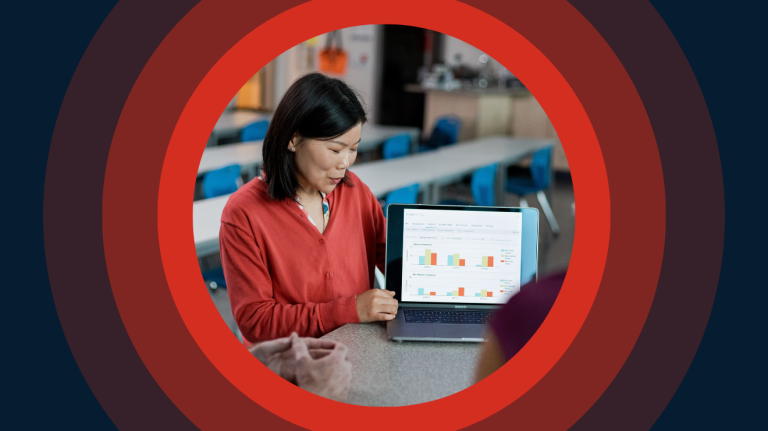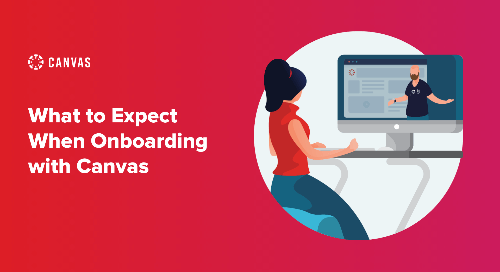It might be too simple to liken onboarding with Canvas to hopping an aircraft to your favourite holiday destination, but it’s probably easier than you think. So buckle up, ensure your seat is in the upright position, and get ready to discover how two universities navigated the change management process, with support from the Instructure team.
Successful change management at UPM
First up, Dr Maria Eliza Ruiz Aguila describes how she led Canvas implementation at the University of the Philippines Manila (UPM). Their change management journey started in the thick of the pandemic in April 2020, with forming a project management team comprising members from executive, faculty, information management, pedagogy, and student affairs offices, among others.
Onboarding kicked off with a team bootcamp, which “prepared us to identify our why, what and how in implementing Canvas,” explains the Dean of the College of Allied Medical Professions. Soon after, the team held a change planning workshop to build their implementation roadmap, which included their vision for adopting a new learning management system (LMS). “We envisioned Canvas as a tool that would enhance and eventually transform teaching and learning in an environment tailored to the resources and context of faculty and students,” Aguila explains.
In June, they piloted Canvas across eight courses in preparation for whole-campus rollout in September 2020.
Aguila says electing faculty ‘Canvas champions’ was crucial to managing change. This team supported other faculty members to use the LMS and liaised between faculty and the project management team about any issues.
Importantly, engaging with Instructure prior to starting their subscription was a huge help, Dr Aguila says. “That lead time was valuable in understanding our own systems, knowing about Canvas and the supports available from Instructure, and recognising how all these fit together as we approached our go-live date.”
Instructure also provided standardised yet customised faculty training. College ‘champions’ then trained others, using face-to-face and small group workshops and synchronous and asynchronous online lessons. “We also had quick guides and how-to videos made available for faculty and some informal sharing sessions for tips and tricks,” she says.
Here’s Dr Aguila’s top five lessons from UPM’s rapid Canvas adoption during COVID-19:
1. Strong executive support drives successful LMS onboarding
Executive-level support makes bureaucratic processes more efficient and effective, Aguila says. “Our chancellor and vice chancellor participated in the onboarding bootcamp, the launch, and the fundamentals faculty training. Their deep involvement modelled how to embrace change. It also facilitated our team’s work in harnessing opportunities and identifying and mitigating challenges, because leaders experienced them first-hand.”
2. Plan for change management
Aguila says UPM’s launch plans intentionally prioritised change management. “We had to consider potential pain points related to introducing a new learning management system at a time when the academic environment and, let's face it, the world, was shifting.
“Our plans focused on having a clear vision, consistent key messages, and training, communication and engagement strategies. Part of managing change has also included being sensitive to any need to recalibrate our plans.”
3. Understand your technical capabilities
“We had to learn the scope and workings of our own information system and how that could be integrated with Canvas,” Aguila says. This included gaining a deeper understanding of the operations and functional relationships between different offices involved in implementing it.
“We put ourselves in the shoes of the tech team, the faculty and the students through our planning and implementation. That way the processes and resources were centred on them.”
4. Learn from other Canvas users
UPM communicated with two universities that had already adopted Canvas, which helped their team anticipate potential pain points and develop mitigating strategies. “It was reassuring to hear their success stories and how they navigated challenges,” Aguila says. It’s instructive to be part of the big community of Canvas users and benefit from shared resources such as community guides and templates.”
5. Leverage the full-service implementation setup offered by Instructure
“Instructure provides proactive support which has guided our way through planning, account setup, training and implementation,” says Dr Aguila, who explains they initially met with their Instructure customer success manager weekly, then fortnightly with some “quick chats in between as necessary.
“These meetings have been instructive and encouraging. Ramzy knows our vision and plans and therefore we are confident his support is tailored to our context and needs. He acts on any concerns or feedback we have and provides updates and critical information.”
For example, in cases where their team encounters competing options, Ramzy talks them through best practices and which strategies have and haven’t worked for other universities. “He provides enough information to help us make informed decisions. He's even our cheerleader when we feel unsure of the next step,” Aguila says.
She adds that this high-level support is particularly valuable for their team, which comprises three health professionals/academics working together for the first time to onboard the LMS. “With Instructure’s support, we know we are working with people who have the experience and expertise to help us achieve our vision for using Canvas.”
Adopting Canvas at a small private university
Jason de Villa, Director of Information and Communication Technologies at Manila’s University of Asia and the Pacific (UA&P), was tasked with finding a full-service learning management system for the private institution with approximately 2,100 students.
They had been using another solution on a limited basis for two years when they started exploring other options. “The first contact we had with Canvas was in November 2016,” he explains, “and it took us until April 2018 to make the purchase decision and begin our implementation.”
Their first question was about affordability. “We were really happy to know Canvas was a cloud-based system, which meant that implementation and financing were a lot simpler,” he says.
Next, they needed to think about ways to cover costs, considering options like integrating them into existing ICT fees or charging a miscellaneous fee. More importantly though, were cost-benefit considerations.
“We needed to ask from the get-go what we would really get out of this project,” de Villa says. “This is one of the most important questions your executive sponsors and university managers will ask when you consider getting an LMS or coming on board with Canvas. Institutions need to make sure the investment will bring something of strategic value to the table.”
Next, they explored how to deploy it, explaining that as a small institution, they had to ensure they had enough personnel to manage the project and identify who would train their teachers.
Equally important was identifying the results they wanted. “It is not just about delivering classes online,” de Villa notes. “You need to think about things like the student experience and learning metrics, which should be clearly identified from the start.” A key factor for UA&P was the easy availability of useful data from Canvas’s data portal and reports page, de Villa says.
Once the decision to go with Canvas was made, everyone worked to a predetermined deployment schedule.
Here are de Villa’s top lessons for onboarding with Canvas:
1. Executive support is crucial
This involves much more than getting a yes to an online platform, he says. “This means key executives understanding what they need to do, especially in terms of policy changes that will support onboarding and rollout of an LMS across the entire institution. From the very beginning, that commitment has to be there.”
2. Ensure adequate IT support
De Villa notes that as a cloud-based system, Canvas is relatively easy to set up. However, you need a team that understands things like how to get data from the system and deal with student and faculty enquiries.
3. Manage different types of adopters
As de Villa points out, not everyone will be happy about a new LMS. “There are different reasons why people resist, and you need strong policies in place to make sure implementation goes ahead with as few hitches as possible.”
One way they did this involved looking at their pedagogical approach as well as the platform. As de Villa explains: “We felt that changing the way teachers approach teaching was equally important, so our training component had a strong pedagogical component and strong platform training.”
You might also want to tailor policies and messaging to different groups, he says. The “laggards” who are slow to adopt, for example, may need messaging around extra support or help with training to help speed up adoption.
On the other hand, you could encourage early adoption with “the equivalent of a carrot”, in the form of incentives such as certificates, deloading, or professional development credits. Your innovators and early adopters can become your Canvas ‘champions’ that train other staff, and whose enthusiasm and energy help facilitate uptake across your institution.
4. Prepare as early as possible
Your courses should be ready for students and teachers to use from day one, or even beforehand, de Villa says. Ideally, have a team dedicated to your LMS rollout. “If I were to do it all over again and change one thing, I would have a training team in place on a full-time basis from the very beginning of implementing Canvas, or any LMS for that matter. It's going to be a multi-year effort. You keep growing into the LMS and getting advantages from it, so having that team in place is important.
“The Instructure team was very helpful in this regard and our first try went smoothly.”
Related Content
 the_five_essentials_for_vocational_learning_platforms.png
the_five_essentials_for_vocational_learning_platforms.pngBlogs
 signs_its_time_to_rethink_your_learning_platform.png
signs_its_time_to_rethink_your_learning_platform.pngBlogs
 from_admin_tool_to_growth_driver.png
from_admin_tool_to_growth_driver.pngBlogs

